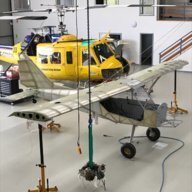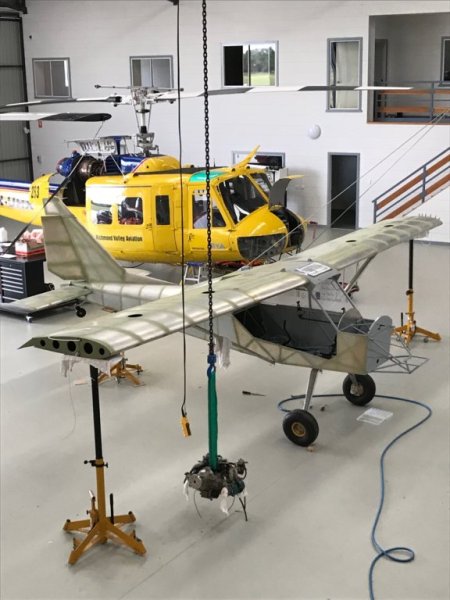-
Posts
16 -
Joined
-
Last visited
-
Days Won
1
About Groppo Australia
- Birthday 30/08/1984
Information
-
Location
Casino
-
Country
Australia
Groppo Australia's Achievements

Member (1/3)
-

Instrument ID help please?
Groppo Australia replied to Builds By Baz's topic in Instruments, Radios and Electronics
I think you will find that the VHF FM (the one with the thumbwheel frequency select) is an old Wulfsburg C-722. The Audio panel does not look like an AMS 42 or 43 unless they regurgitated the same model number for audio sectors later on but the AMS 42/43/44's that I know have been around since the '80's. It looks about the same size as a NAT AA12 which would be your best replacement option. Try some old Peugeot cars for a voltmeter. It looks remarkably French. -
For anyone interested in the Groppo Trail, we are currently part way through construction of our first. We have started a blog on our website to document the building process. This blog is a little way behind where we actually are in the build but we are doing our best to keep it updated. Any interested parties can view it at www.groppoaustralia.com.au/blog Anyone with questions, thoughts, comments or general observations please get in touch here or via our website
-

RAA Pilot Certificate and 25nm
Groppo Australia replied to BirdDog's topic in AUS/NZ General Discussion
I think you will find the intent of the rule is exactly what, you know in your bones, it is trying to achieve. I also think that if you break it down, you will find that it says exactly that. It is just poorly worded. The "requirement", in this instance, is what you, as the pilot, need to do to legally act as pilot in command of an aircraft traveling more than 25nm from your original departure aerodrome. By saying that consecutive 25nm flights do not comply with that requirement, means you are not compliant with the requirements that allow you to be pilot in command if you venture more than 25nm from the aerodrome of origin, which, you could safely say, would be where you did your daily inspection and started the aircraft for the first time that day. Being that consecutive means to follow each other continuously, then it is safe to say that if you flew 25nm's, overnighted, flew another 25nm etc etc then no one would care because on each given day you are literally within eyesight of where you departed, unless you are running around at 500ft. Either way, pretty hard to get lost or get caught in weather.. but considering that, it would take you 3 days to go 75nm and then 3 days to come back, in which case you have far too much time and money on your hands and would be far better off spending 5 days doing your cross country endorsement and then flying the 150nm round trip on the 6th day and do it in one day. Anyone that tries to find grammatical loopholes in aviation regulations, especially inexperienced pilots, contrary to what everyone knows the intent of the regulation to be, are a danger and detriment to the themselves and the rest of the aviation community. Far better to play by the rules. -
Definitely a wise purchase.
-
The primary radar will have picked your aircraft up as a blip on the screen at a given bearing and distance from the station (if you are within its range). The SSR will have interrogated your transponder and it would have replied with a code (normally 1200 for VFR). Because the SSR array is directional, it knows what direction your transponder replies are coming from and measures the interrogation-reply round trip time to calculate a distance from the station. When this is compared with the primary radar returns, they can identify the blip as your aircraft. If you have mode C then your transponder will identify your aircraft and also give the altitude of your aircraft. If another aircraft is using a TCAS/TCAD then that aircraft will know your exact position in relation to their aircraft. With ADS-B, your transponder takes a feed from the GPS and transmits your GPS position. So yes your transponder was most likely the only thing that allowed ATC to foresee possible conflict.
-

Hello from a Groppo Distributor in Aus
Groppo Australia replied to Groppo Australia's topic in Just Landed - Welcome
It took me a while to get what you were banging on about... good one :D -

Hello from a Groppo Distributor in Aus
Groppo Australia replied to Groppo Australia's topic in Just Landed - Welcome
Thanks. We sometimes get bogged down with the day to day running of the business but will strive to keep updates for any interested parties -

Groppotrail - Folding Wings
Groppo Australia replied to Super Cub's topic in Aircraft General Discussion
Your point is well taken and I appreciate the input. As I said I am not an aircraft designer nor am I a very avid follower of recreational aviation, although it is something I learn more about every day. I understand your point with regard to the Groppo's folding wing and the connection of flight controls, however, the manner in which the ailerons are connected and disconnect is really quite foolproof and if one were to mess it up I would seriously consider their ability to safely navigate the skies. With regard to helicopter dual controls, which really is beside the point I suppose, I have yet to see a helicopter who's dual controls are not directly connected to the primary controls so to say the primary controls don't get interfered with is not really an accurate statement because if the dual stubs get jammed on something then the primary controls are jammed too. With regard to the fatal accidents due to re-rigging of the flight controls, I am not aware of the numbers but being that the Trail is push/pull tube aileron and elevator control, rigging is not really an issue in this instance. The folding wings you mention that have "been around since the ark" I am not sure have ever been prevalent in commercial aircraft. Most certainly such iconic machines as the F4U, A-1, F6F and most carrier borne aircraft to this day sport such features but I am not sure if it would really work in a high winged aircraft. I may be totally wrong (as I often am). Either way, as our Trail is currently under construction, it is hard for us to know what will be an issue and what will be a selling feature. But most certainly it is a robust and well designed little machine.. will keep you posted on how it goes when its flying -
ATC has primary radar and secondary surveillance radar.. primary radar works as most people understand a radar to work.. SSR interrogates your transponder and they match your primary return with your transponder reply to get a position fix on your aircraft. Without a transponder you will just be a reflective object on the bearing you are from ATC's primary radar.
-

Groppotrail - Folding Wings
Groppo Australia replied to Super Cub's topic in Aircraft General Discussion
I think whilst it may be possible getting controls to auto disconnect to facilitate a folding mechanism, getting that certified would be difficult without some kind of non automated fail safe.. I am not an aircraft designer so I am not sure but certainly in the GA world flight controls need at least 2 locking mechanisms which is usually the torque of the nut and a split pin or lock wire. It could be feasible to use a self locking nut (nylon or metalock) but I think most people are most comfortable with something that has no possibility of unwinding under vibration. In GA it is not difficult to get an authorisation to remove dual controls in helicopters provided that no hand tools are required so I don't see why that wouldn't or couldn't apply to flight controls in a recreational aircraft. -
Hello all. Have signed up as we are a distributor for Nando Groppo aircraft in Australia. Most of our time is taken up maintaining helicopters but thought that the RA community in Aus is definitely worth getting to know so we bought a Trail and currently in the process of construction.
-
CAO 20.18 is where you will find the answers
-

Groppotrail - Folding Wings
Groppo Australia replied to Super Cub's topic in Aircraft General Discussion
That is true, I think in the UK for certification, they had to replace that with a castellated nut and split pin. We plan on drilling the bolt and using an 'R' pin to prevent the wing nut from backing off. I think the reason for the wing nut is to make it possible to fold the wings without the use of any hand tools and I think an 'R' pin will achieve both functions of locking the nut and still making it a job that requires no tools. -

Groppotrail - Folding Wings
Groppo Australia replied to Super Cub's topic in Aircraft General Discussion
Hi all, I am a little late on getting on this site but I will try to answer a few of the questions. We are currently building one in Casino. Firstly it is a fairly big build but not at all a complex one. I think the quoted 500 hours is pretty much on the money if one was to go rip, tear, bust. As an aircraft maintenance facility, we are building ours a little more aligned to the aviation standards we are accustomed to and by doing so has probably dragged things out a little more than needs be. Having said this, the quality of the kit is surprisingly good in that everything is obviously laser cut and as such, everything fits together really well. As it is our first build, we have made a few muff ups but nothing major, just time consuming. The construction manual has very good drawings but a bit light on with instructions, this and the fact it has been translated from Italian makes some of the steps a little confusing but they provide a lot of photographs to assist and a picture speaks 1000 words. As ours is not flying yet, we are unable to give any kind of realistic performance data or comparison to aircraft like the Savannah, however, and I do not want to sound like I am "dissing" the Savannah as I think they are an awesome little plane, it appears to be a more robust design than the Savannah and I personally think it has way nicer lines than the Savannah. With regard to the confusion about whether it is a Trial or a Trail, this was a question we asked the factory, in Italy it is called a Trial and elsewhere it is Trail. Apparently the meaning is the same. As for costing, I would have to check the figures, but I think it has cost us about AUD$35K so far although we did buy a used 912. All that is left is avionics and paint. Any other questions, just drop me a line. Visit www.rvaviation.com.au for contact details. -







